Suunto 5 Peak review: a sleek, sub-40g runner's watch with a few rough edges
A watch so light you’ll forget you're wearing it, but does the Suunto 5 Peak’s substance weigh up against the competition?
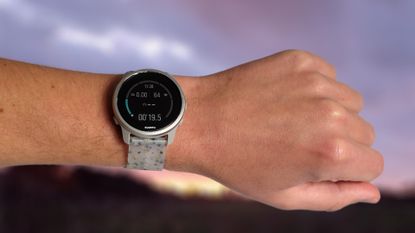
The Suunto 5 Peak is a breezy, comfortable, low maintenance fitness watch with some advanced features that see it leapfrog over a classic smartwatch. Its software is a bit clunky and the heart rate results are patchy, but many will prefer wearing this over a chunky runner’s watch.
-
+
It’s comfortable and light
-
+
The battery lasts a long time
-
+
Has turn-by-turn route navigation for hikes
-
-
The interface is a little slow and clunky
-
-
HR results are not super-accurate
-
-
No blood oxygenation readings
Why you can trust T3
Launched in January 2022, the Suunto 5 Peak adventure watch is a revamp of one of Suunto's older smartwatches, adding new features and an updated interface, but contained in a streamlined and budget-friendly package. But is it worthy of consideration against the rest of today's best outdoor watches or best running watches? I put one to the test to find out.
The first thing to note is that the Suunto 5 Peak is not exactly what it appears to be. On the outside it looks like an accessible smartwatch, injected with some of the playful style of a Swatch watch if you pick one of the snazzier straps. It’s light, it’s small; far removed from most Garmin or Coros bands.
On the inside the Suunto 5 Peak is a lot closer to those enthusiast fitness watches, though. It has full GPS, a sunlight-loving screen, long battery life, workout guidance and offers the ability to navigate hikes and bike rides phone-free.
This unlikely combination makes the Suunto Peak a charmer, even if it is lacking in some areas. The Suunto 5 Peak interface is not nearly as slick as the Garmin Venu 2’s, a watch you can pick up for similar money. And its heart rate results are okay at best, with a tendency to lose the plot on occasions.
We had similar issues with the slightly more advanced Suunto 9 Peak, but the problems seem less glaring when the Suunto 5 Peak costs significantly less (you’ll pay around $329/£260 for the watch). So what else do you need to know? Read on for my full Suunto 5 Peak smartwatch review.
- Find the best cheap smartwatch if you're on a limited budget
- Get smart and stylish with the best hybrid smartwatches
- Hybrid watch vs smartwatch: which is better?
Suunto 5 Peak review: design and build
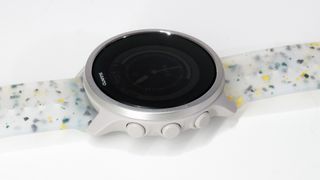
Look and feel are two of the big Suunto 5 Peak draws. It has a 43mm-wide watch face, trim for the class, and is extremely light at 39g. That includes the strap.
A Suunto 5 Peak is lighter than a Garmin Venu 2, a Fitbit Sense or an Apple Watch Series 7. You will often forget you’re even wearing this Suunto, which is about the highest praise you can get for a wearable’s comfort.
There’s a more practical benefit too. Low weight means the Suunto 5 Peak does not build up momentum on your wrist if you wear it for run tracking. This helps the heart rate sensor rooted in place on the back, and means you don’t have to wear the strap quite as tight as some.
The impact of the Suunto 5 Peak’s appearance varies quite a bit based on which model you choose. I have the version with a translucent Ridge Sand strap and the brighter stainless steel bezel.
This makes the most of the breezy style of the watch’s design, but Suunto makes much plainer black, dark green and dark grey versions too. That refers to the strap. The bezel is either lighter steel or dark grey/silver.
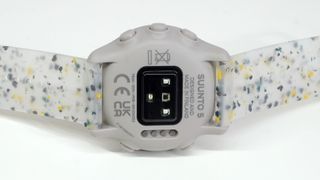
One part of the outer hardware is sure to raise a few eyebrows, though. The top-most layer of the Suunto 5 Peak screen is plastic. It’s about the worst material Suunto could have used here, as even tough plastic is much easier to scratch and scuff than basic treated glass.
This is not a good look when even the cheap Xiaomi Mi Smart Band 6 has a glass screen surface. The Suunto 5 Peak costs seven times as much as that Xiaomi.
I am yet to put a scratch on this outer plastic, but you might want to consider buying a screen protector to keep it that way. Suunto doesn’t sell them. Third parties do.
Suunto 5 Peak review: Display and interface
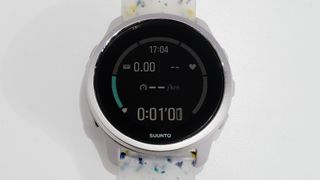
The Suunto 5 Peak has a small 1.1-inch screen of 218 x 218 pixel resolution. At first glance there is more than enough room for a larger display. A fat black border sits between the display’s perimeter and the stainless steel bezel.
However, this is entirely normal. The brand new Garmin Instinct 2 still has an awkward-looking display and we need to take into account this is a specialist kind of screen, not the OLED kind where costs are eroded through sheer ubiquity.
The Suunto 5 Peak has a transflective screen that, unlike OLED, can be passively lit by ambient light. It barely consumes any power, and displays the watch face 24/7 as standard.
After complaining about the plastic surface, I actually think it does the screen’s visibility a favour indoors, offering significantly better indoors visibility than the Suunto 9 Peak. The front light is brighter as standard too — likely because there’s no option to change its brightness here. This watch also has a simpler display construction as there’s no touch layer. It probably helps.
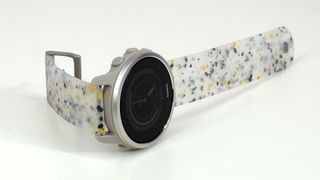
For all its smartwatch-adjacent style, the Suunto 5 Peak is button-operated only. There are three buttons on the right side, two on the left. Too many? Probably, and it’s too easy to accidentally press one on the opposing side while navigating as their action is a bit squishy, lacking a clear actuation point.
You use them to cycle through a slightly clunky and slow menu system that doesn’t seem a perfect fit with the relatively stylish outer shell. But it is at least simple enough to understand.
Pages below the Suunto 5 Peak watch face show stats like your heart rate, sleep data, step count and fitness level (a friendlier way to relay VO2 Max scores). Pages above the watch face let you access the fitness tracking and navigation modes, the timer and settings menu.
The Garmin Venu 2 is a lot slicker, and the Suunto 5 Peak interface ends up feeling more like that of a budget tracker from Xiaomi or Realme. You get used to it, but may initially feel disappointed given this isn’t exactly a cheap watch.
Suunto 5 Peak review: adventuring skills
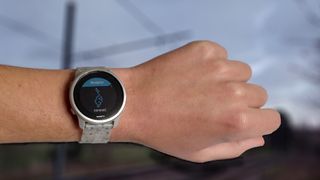
Don’t dwell too long on the ways the Suunto 5 Peak isn’t quite cutting-edge in operation, though, as it can do stuff plenty of more glossy watches cannot. Several of the key features sit in its Navigation menu.
The Suunto 5 Peak offers turn-by-turn navigation, which will be of particular interest to hikers who want to stick to planned routes without being glued to their phone’s GPS half the time.
Here’s how it works. You plot out your route using the Suunto app on your phone, tapping at waypoints on a map. These are transferred over to the watch, to be accessed without any further required communication with your phone. You’ll see prompts when you should turn, or if you leave the route, on the watch.
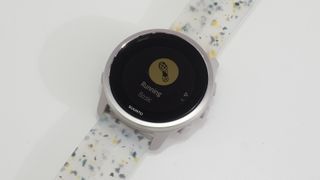
You won’t see actual map data on the Suunto 5 Peak itself, just a route and an elevation graph. However, Garmin’s watches don’t offer full mapping until you spend a whole lot more on something like the Fenix 7 anyway. It does not seem a major problem here.
Suunto also lets you import routes downloaded online, sent from friends or created using other apps, as it supports gpx file imports.
The phone still plays a big part, then, as does pre-planning. However, you can also set POIs (points of interest) when you are out and about just wandering around.
Initially these just show up as co-ordinates. Not friendly. But you can then save them with a label, perhaps to let you know where you parked your car or pitched your tent. Later on you can then use the POI mode to find them again. We can’t guarantee you won’t find an expected river blocking your path, mind — no maps, no warning about such obstacles.
Finally, basic tracking modes like “walk” show a breadcrumb trail of your route, which — again — is handy for on-the-fly hiking navigation if you think pre-planning a route spoils the fun.
Suunto 5 Peak review: tracking and accuracy

The Suunto 5 Peak can also be paired up with external sensors. It supports HR sensors, foot pods, power meters and bike cadence sensors. However, they’ll need to use Bluetooth as the watch does not support ANT+, unlike the older Suunto 5 generation.
This watch also lacks blood oxygenation readings, which you do get in the Suunto 9 Peak and countless watches at this price or less. It is no monumental loss, though, as watch readings are usually not to be trusted.
I initially though the extra light in the Suunto 5 Peak heart rate array was an SpO2 LED that simply was not being used. It’s actually a yellow LED, there to improve the performance of the sensor with a wider array of skin tones.
That’s great stuff, but the Suunto 5 Peak’s heart rate readings are patchy. At times it will work perfectly well, tracking changes in exertion reasonably quickly and getting within a handful of bpm from the readings of a chest strap HRM. However, it also has a habit of losing the plot and reverting to what it thinks are sensible baseline readings. The Suunto 5 Peak then appears to try to track changes from that level.
For example, after the occasional tempo change the Suunto 5 Peak hung around at 135-140bpm when the reality was closer to 157-165bpm. I saw a similar issue in the Suunto 9 Peak.
There appears to be something of an over reliance on these poorly estimated figures in the Suunto 5 Peak. It loves hanging around at ~160bpm, is often reticent to drop below 120bpm during tracked runs if you walk for a bit. It missed a few speed spurts, and the resulting HR increase, and if your workouts have some breather moments, the slow uptake on a low heart rate may push up your average reading for the session a little.

A watch is likely to use these “likely” heart rate zones when the sensor itself isn’t picking up clean enough data. It’s no great surprise the Suunto 5 Peak’s is clear not best-in-class. The HR monitor hardware only uses a single photosensor, compared to the four of Garmin’s Elevate v4 array.
These flaky readings also seem to throw off the Suunto 5 Peak’s “fitness level” stat. Its readings are significantly lower than those recorded by the Suunto 9 Peak and Garmin Epix/Fenix 7/Venu 2.
Will the Suunto do the job for everyday fitness tracking? Absolutely. It’s all-day results are decent and not every workout I recorded had these issues. But if you're looking for rock-solid reliability, the Suunto 5 Peak does not seem to offer it with the software it has at the time of review.
GPS reliability is much better. 7.5km recorded walks and runs were within 0.5% of those of the Garmin Epix. On one occasion the disparity was less than 10m. For best results, make sure the watch has achieved a GPS lock before you start tracking proper. It seems to default to accelerometer-led estimates beforehand. I tend to start tracking runs before a short warm-up walk, and it led to a notable overestimation of the distance travelled in the first couple of minutes, throwing off the final measured distance a little.
The Suunto 5 Peak is also not the quickest to lock on to a GPS signal, and this seems to vary from day to day. At times it takes just a handful of seconds. Perfect. On other days it has taken upwards of a minute. Not so great. There seems to be no easy-to-identify reason either, as some of the quickest were days when the watch hadn’t been sync’d to the phone app for a couple of days — which Suunto says you should do for the best results.
Garmin’s Venu 2 is more consistent, and quicker in general, here. But I don’t think it’s a show-stopping issue when there were no GPS drop-outs and the accuracy seems solid. The collection of supported satellite arrays is great too: GPS, GLONASS, GALILEO, QZSS and BEIDOU.
Suunto 5 Peak review: battery life
Battery life brings more good news. Suunto says the 5 Peak can last up to 10 days in its “watch” mode. I think it’s actually capable of lasting a bit longer, if anything.
With 24/7 heart rate monitoring and sleep tracking, the watch lost eight percent charge in 24 hours. This suggests it might be able to last up to ~12 days. However, this was without using phone notifications. These activate the vibration motor, which will drain the battery significantly quicker if it’s firing off all the time.
To get a more holistic view I monitored the battery several over a five day period with normal use. After those five days, including two GPS-tracked sessions of more than an hour each, the Suunto 5 Peak lost 47% of its charge.
This still suggests it can last 10 days with a healthy amount of tracked exercise, despite a hour of GPS tracking consuming 5% battery life, just as Suunto claims. There are also lower power GPS modes rates for 40 and 100 hours of use.
The secret sauce here is, again, not to use smartphone notifications. I turned these off after a couple of days. While messages look perfectly decent on the Suunto 5 Peak’s screen, and you can even send canned replied to them, the watch’s haptics are basic, a fairly crude rumble. And the watch seems happy to buzz away multiple times in quick succession from the same app source when a WhatApp chat kicks off. It gets old pretty quick. And by “old” I mean extremely annoying.
Suunto tries to make sure you’re not left with a dead watch on your wrist, by sending a couple of on-screen suggestions to charge when you hit certain low battery thresholds. Still, as GPS battery drain is fairly low, you can take the Suunto 5 Peak out for an hour’s run while it’s close to circling the drain without too much worry.
Suunto 5 Peak review: verdict
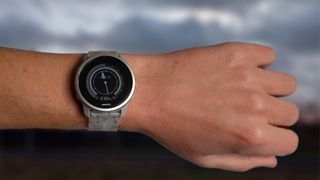
The Suunto 5 Peak is a light, fairly petite and unobtrusive-looking watch that should appeal if you don’t want a giant wrist-hugger, but do like the kind of features such watches typically provide. You can connect it to external sensors, and use some advanced navigation features that offer turn-by-turn navigation for pre-planned routes.
It lasts a long time too, our testing suggesting it’s possible to reach beyond the claim 10 days, and match it even with several hours of GPS tracking.
However, you do have to put up with software that feels a little clunky, a plastic screen more likely to get scratched or scuffed than the competition and somewhat unreliable heart rate data. The Garmin Instinct series (see T3's guide to the best Garmin watches for more on that) and Venu 2 are better all-rounders, but the ultra-low-weight matches with a power-frugal display remains a compelling reason to buy.
Upgrade to smarter living
Get the latest news, reviews, deals and buying guides on gorgeous tech, home and active products straight to your inbox.
-
 Amazon's biggest sci-fi hit gets 80s superstar boost for season 2
Amazon's biggest sci-fi hit gets 80s superstar boost for season 2Vault alone...
By Rik Henderson Published
-
 Roberts revives its 1970's collection with new premium radio, the Rambler Classic
Roberts revives its 1970's collection with new premium radio, the Rambler ClassicThe Roberts Rambler Classic is the perfect balance of sound and style
By Lizzie Wilmot Published
-
 New Panerai watch is a stylish piece – and a dream for lefties!
New Panerai watch is a stylish piece – and a dream for lefties!This exudes classic Italian style
By Sam Cross Published